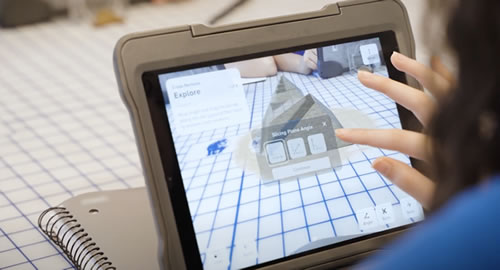Immersive, experiential technology is transforming how both students and teachers learn. Augmented and Virtual Reality (AR and VR) provide deeper engagement, opportunities for collaboration, and hands-on learning that places newly acquired knowledge and skills in context.
For students, immersive technology can make abstract concepts tangible through interactive visuals. But immersive technology is useful for teachers, too, powering professional learning that helps educators translate research and theory to actionable practices through dynamic examples.
When purposefully designed, augmented reality opens equitable pathways to deep student learning.
Created in partnership with Verizon Innovative Learning, an education initiative that supports digital equity and inclusion in education, McGraw Hill AR is a free augmented reality app that provides engaging, bite-sized experiences that promote deep conceptual learning. The app makes complex concepts in algebra, social studies, and ELA more tangible through powerful, interactive visuals.

“What I liked the most about using the app was that that you could see around it, and you could move around, and see all around the shape.” – Middle School Student from Hawkins Street School, NJ
Immersive technology must be built on sound pedagogy and content.
The activities in McGraw Hill AR were purposefully selected based on which learning objectives could be best supported by augmented reality, leveraging immersive experiences deliberately for meaningful instruction. Each standards-aligned activity follows a consistent pedagogy and was built from high-quality content.

Immersive learning has the power to promote equity.
On Verizon Innovative Learning HQ, educators can find free standards-aligned lesson plans to accompany each activity in the app, designed to make next-gen tech more accessible to all educators and school communities and inspire all students to become innovators and creators. The multimodal nature of immersive technology provides more access points for learners, engaging them in concepts that previously may have remained out of reach.

We’ve only just begun to tap into the potential of immersive learning for students.

McGraw Hill AR is always expanding – five more social studies activities will be released by December 2023, science activities will arrive in the fall, and Spanish versions are live now. Chromebook compatibility is coming soon, too, making the app accessible to schools without tablets or phones in classrooms, further broadening the reach of immersive learning.
Immersive learning isn’t just for students. Teachers deserve engaging professional learning, too.
Educators are life-long learners. If we expect them to continue to refine their craft and adapt to changing classrooms, they deserve innovative, engaging, and meaningful professional learning opportunities.
McGraw Hill Plus™ for PreK–12 is an innovative new tool that simplifies educators’ daily workflow by connecting and transforming data from multiple digital solutions. It uses this rich data to generate personalized instructional recommendations, driving scalable personalized learning and empowering schools to implement transformative instructional models, like mastery-based learning.
McGraw Hill Plus for PreK-12 reaches its full potential in the hands of a skilled, knowledgeable, and creative educator who has been given opportunities to understand what it means to personalize instruction, and what modern classrooms can look like. That’s where McGraw Hill’s Immersive Classroom Experience comes in.
Virtual reality provides teachers with a first-hand look at personalized learning in action.
Available using Oculus or on desktop, the Immersive Classroom Experience uses virtual reality to help teachers explore how they can leverage McGraw Hill Plus for PreK-12 to personalize learning and foster student agency. When teachers “enter” the classroom, they can interact with students and explore the tools and materials being used in the room.

Students in the virtual reality classroom explain to visitors where they are in their personal learning journeys and how the student-directed environment empowers them to thrive. They discuss how the Standards and Skills Graph (a data visualization tool within McGraw Hill Plus) helps them better understand their areas of growth, and how various curriculums and materials work together in their classroom. Ultimately, VR provides a controlled, safe, flexible environment for teachers to explore what their classroom could become, and how to make that transformation a reality.
Educators deserve to own their learning journeys, too.
Immersive learning makes complex concepts tangible. VR brings to life transformative instructional models and innovative uses of technology for teachers. On-demand professional learning resources that are related to the observed best practices are linked directly within each zone of the Immersive Classroom. Teachers can interact with students, explore the classroom materials, and leverage the corresponding professional learning resources in a manner and pace that suits their needs.

Immersive learning experiences have the power to place ownership in the hands of more students and more teachers.
Dr. Shawn Smith, Chief Innovation Officer of McGraw Hill School and whose team created both McGraw Hill AR and the Immersive Classroom Experience within McGraw Hill Plus for PreK-12, believes AR and VR hold exciting implications.
“We’ve just begun to explore the possibilities with immersive, experiential learning for students and teachers,” says Smith. “With powerful, dedicated partners like Verizon Innovative Learning and our own team of learning scientists, we can deliver deeply engaging learning experiences to more teachers and learners by expanding our VR and AR to more disciplines, more learning objectives, and more applications of pedagogy.”
Content provided by:

